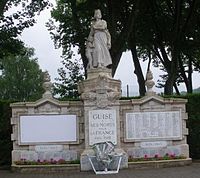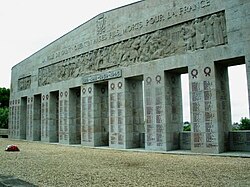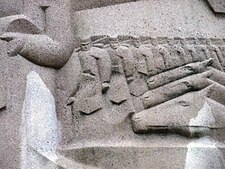War memorials (Aisne)
The War Memorials of Aisne or Monuments aux Morts of Aisne are French war memorials in the Aisne, in the region of Picardy, commemorating those men of the Aisne region who died in World War I
Background
This region saw considerable action throughout World War I. In 1914, the Allied armies retreated through the region before the advancing German armies, who were following Von Schlieffen's plan of attack. At the Battle of the Marne, the German army's advance was halted and they retreated to the Aisne region and then dug in there before the so-called "race to the sea". The "war of movement" was to be short-lived and replaced by a static war of attrition, dominated by the trenches. The region was thereafter an integral part of the Western Front, the "Chemin des Dames" area, in particular, seeing the French army in continual action. This article deals with the local memorials which were erected in every city, town and village in France.
Some of the monument aux morts in the Aisne region
| Work | Image | Location | Date(s) | Subject, notes and references |
|---|---|---|---|---|
| The monument aux morts at Achery. | Achery | 1925 | The Achery war memorial features work by the sculptor N. Staquet. The inauguration took place on 29 July 1923. The same statue, which features a French infantryman or "poilu" can be seen at Versigny, this war memorial being inaugurated on 12 July 1925.[1] | |
| The monument aux morts at Acy | Acy | 1924 | The Acy war memorial entitled L'Ange de l'Apocalypse is one of the sculptor Henri Charlier's works and was completed in 1924. It stands in front of the parish church.[2] Also in Acy, and on the Plateau d’Acy is the Pleureuse d’Acy, another Charlier work, this remembering the dead of the 1939–1945 war.[2][3] | |
| The monument aux morts at Braine | Braine | 1922 | The war memorial at Braine was inaugurated on 10 December 1922 and features a bronze allegory of France by the sculptor Charles Breton. Breton had worked on the war memorials of Saint-Mandé and Fontenay-sous-Bois in Val-de-Marne and that at Saint-Alban-sur-Limagnole in Lozère. The Braine bronze memorial was produced by the foundry Leblanc-Barbedier et Fils.[4] | |
| The monument aux morts at Bucy-lès-Pierrepont | Bucy-lès-Pierrepont | 1922 | The Bucy-lès-Pierrepont memorial features a work by the sculptor Charles-Henri Pourquet. Cast by the foundry Val d'Osne, the work was given the title Poilu No.853. It featured in the Val d'Osne catalogue, proved to be popular, and can be seen on war memorials throughout France. ThIs monument was inaugurated on 23 July 1922.[5] | |
| The Monument aux morts at Chateau-Thierry | Château-Thierry | The composition here is most dramatic and the sculptor Achille Jacopin has produced a sculpture depicting a dead soldier lying flat on the ground.[6] | ||
| The monument aux morts at Chauny | Chauny | 1930 | Émile Pinchon was the sculptor of the war memorial at Chauny with inauguration taking place on 6 July 1930. A maquette of this work is kept at the Historial de la Grande Guerre at Péronne. The Amiens born Pinchon's composition features three women. The central figure represents "La Republique" with "Douleur" on one side and "Jeunesse" on the other.[7] | |
| The monument aux morts at Chavignon | Chavignon | 1933 | Chavignon's war memorial involves sculptural work by Henri Albert Lagriffoul. There are two bas-reliefs on the monument, one depicting a soldier holding an antique sword and the other a woman carrying her child and a sheaf of wheat. The monument also remembers the action of the 4th Regiment of the French Army and those who fell in the action to expel the Germans from Chavignon on 23 October 1917.[8]
This monument was inaugurated on 1 October 1933. | |
| The monument aux morts at Danizy. | Danizy | 1923 | At Danizy the war memorial features work by N. Staquet; a depiction of a standing soldier. It was inaugurated on 15 August 1923.[9] | |
| The monument aux morts at Essigny-le-Petit | Essigny-le-Petit | At the commune of Essigny-le-Petit is an Établissements H. Jacomet edition by the sculptor Étienne Camus. In bronzed cast iron it is called Poilu baïonnette au canon and is a well-known piece in France, as is Jacomet's Poilu au repos, another work by Camus. Jacomet's works are found in the Somme and Oise regions.[10] | ||
| The monument aux morts at Fargniers | Fargniers | 1926 | In the commune of Fargniers east of Tergnier, the war memorial features a work by Paul Landowski whose work we encountered at Ault in the Somme. Fargniers suffered much destruction in the Great War and like many other communes was awarded the Croix de Guerre in recognition of her sufferings. This monument was inaugurated on 11 November 1926.[11] | |
| The monuments aux morts at Foreste | Foreste | 1924 | The war memorial at Foreste features sculptural work by Raoul Josset. Josset had worked as an interpreter for the US troops during the Great War. The Foreste memorial was inaugurated in 1924. After the war Josset emigrated to the US and lived in Texas, where he completed several public works.[12] | |
| The monument aux morts at Guignicourt. |  |
Guignicourt | 1924 | The war memorial at Guignicourt was inaugurated on 20 September 1924. The sculptor is unknown. The composition shows a couple, bent before some graves, perhaps including that of their son. The woman carries a bouquet of roses and is supported by her husband.[13] |
| The monument aux morts at Guise. |  |
Guise | The Guise war memorial features a work by sculptor André Joseph Allar. Allar depicts a woman, meant to represent Guise, who comforts a child.
Guise was where Jean-Baptiste Godin, the humanist and philanthropist, built his factory which was intended as an example of how the working classes should be treated. Alongside the factory, Godin had built all the amenities which he considered the workers should have; housing, laundry facilities, a school, a theatre, gardens, a swimming pool, etc. In the grounds are a monument which remembers those Familistere men who lost their lives in the Great War, the Monument aux morts du Familistère de Guise, sculpted by the brothers Jan et Joël Martel (1896–1966). These brothers were well known as avant-garde and cubist sculptors.[14][15][16] Guise was also the scene of a fierce battle in 1914 when the 5th French Army, retreating before the advancing German armies, stopped their retreat and engaged with the enemy. The 5th Army was commanded by General Lanrezac and the Martel brothers were sculptors of the monument which marks this battle. Several photographs of the "Lanrezac monument" are shown below as are photographs of the Familistere monument aux morts. |
Images of Guise
- The 5th Army monument at Guise
- Detail from the 5th Army monument at Guise
- Detail from the 5th Army monument at Guise
- Detail from the 5th Army monument at Guise
| Work | Image | Location | Date(s) | Subject, notes and references |
|---|---|---|---|---|
| The monument aux morts at Holnon. |  |
Holnon | 1926 | The Holnon war memorial features a work in bronze by the sculptor Grégoire Calvet. The monument was inaugurated on 30 May 1926.[17] |
| The monument aux morts at Jaulgonne | Jaulgonne | 1921 | At the village of Jaulgonne near Château-Thierry the war memorial has sculptural work by Louis Bertrand. The monument was inaugurated on 9 October 1921.[18] | |
| The monument aux morts at Laon. | Laon | 1926 | At Laon, the capital of the Aisne region, the war memorial features sculptural work by Marcel Gaumont.[19] | |
| The monument aux morts at Mézières-sur-Oise | Mézières-sur-Oise | 1923 | The war memorial in Mézières-sur-Oise features a bronzed cast-iron work by the Durenne foundry which was inaugurated on 10 June 1923. The authorship of the relief is not known and the same relief can be seen at Becquigny. In the parish church in Mézières-sur-Oise there is a war memorial by Charles Desvergnes (1860–1928) called Ange de la reconnaissance couronnant un soldat.[20][21] | |
| Montaigu | Montaigu | 1926 | The Montaigu monument aux morts has sculptural work by Eugene Durassier and was inaugurated 20 May 1928.[22] | |
| The monument aux morts at Origny-Sainte-Benoite | Origny-Sainte-Benoite | Marius-Léon Cladel, who created a monument in Appilly in the Oise, was the creator of the Origny-Sainte-Benoite war memorial. | ||
| The monument aux morts at Pontavert | Pontavert | 1926 | At the commune of Pontavert there is a war memorial with a relief by Norbert Gaillard. The monument dates from 1926 and was inaugurated on 3 October 1926. The relief features a helmeted victor in profile whose right hand shows a winged figure holding in the left hand a crown of laurels. A gallic cock to the rear is accompanied by the word "PAX", the Latin word for peace. | |
| The monument aux morts at Saint-Quentin |  |
Saint-Quentin | 1927 | Saint Quentin, one of the major cities of the Aisne region, suffered major damage during the Great War. The war memorial, designed by the Prix de Rome winning architect Paul Bigot, has bas-reliefs by Henri Bouchard and Paul Landowski. The Saint-Quentin monument aux morts was unveiled on 31 July 1927 in the presence of General Debeney.
Bigot built a 31 metre long monument which consisted of nine columns supporting one huge pediment and on these columns are inscribed the names of those who died in the Great War, whether as soldiers or civilians killed during the German occupation. On the pediment itself are three bas-reliefs. That at the centre shows life in the trenches and scenes from the civilian exodus of March 1917 and at each end are bas-reliefs, one depicting a scene from 1870 and the other remembering the conflict of 1557. The wording on the monument was subsequently changed to remember those who had lain down their lives in the 1939–1945 conflict.[23] |
Images Saint-Quentin
| Work | Image | Location | Date(s) | Subject, notes and references |
|---|---|---|---|---|
| German military cemetery |  |
In a German military cemetery near Saint-Quentin which holds the graves of 8,229 soldiers, there is a monument erected in memory of the soldiers from both sides of the war - "morts pour leur patrie" (note the use of the word "leur"). The sculptor Wilhelm Wandschneider created an imitation Greek temple with four Doric columns. On the rear wall is a sculpture with the inscription "Requiescant in pace mortui hic pro patria 1914–1918". On two pedestal are bronze statues representing two warriors and the year 1915. | ||
| Soissons |  |
Soissons | At Soissons, the war memorial has statues by Albert Bartholomé and a series of bas-reliefs by sculptor and medallist Raoul Lamourdedieu. It was as late as 21 July 1935 that Soissons finally saws her monument aux morts unveiled by the President, Albert Lebrun. The Soissons monument had first been designed by Bartholome in 1914 as a monument to celebrate the history of Soissons but it was decided to create the memorial as the City's monument aux morts and it was erected in 1926. However the Great War veterans ("Les Anciens Combattants") were unhappy with Bartholome's statue of a woman at the very top of the monument, the so-called "Dame Blanche", and after much discussion the "Dame Blanche" was moved to a position in the St Crepin park and eventually replaced on the top of the monument aux morts by the four men carrying an "eternal flame" which was completed by a pupil of Lamourdedieu. The monument comprises a central pedestal with the "eternal flame" at the very top and Lamourdedieu's reliefs are on the sides of the pedestal. At each corner of the monument are Bartholome statues. In the middle section of the pedestal there are bas-reliefs on the south and east facing sides. In one Lamourdedieu depicts a group of soldiers and in the other a winged female figure representing "Victory" protects another two soldiers, one of whom is wounded. On the west facing side of the lower part of the pedestal the bas-relief depicts the King of France and Joan of Arc entering Soissons on horseback on 23 June 1429 and on the south facing side the bas-relief depicts the story of the "Vase of Soissons". A soldier is seen crushing the vase under the eyes of Clovis and the messengers of St Remigius. The north facing bas-relief shows the evacuation of the City. The statue on the north west side depicted a "citizen" holding a scroll. The inscription readsIn the south west corner is a knight carrying a sword. The inscription tells his story
The south east and north east facing corners have statues depicting French soldiers of the Great War.[24] |
Images for Soissons
- The Soissons War Memorial
- Part of one of the bas-reliefs on the Soissons monument aux mort
- Part of one of the bas-reliefs on the Soissons war memorial
In Soisssons is a monument by Jan et Joël Martel, erected in 1925 to commemorate the activities of the "coopératives dans la reconstruction des régions sinistrées après la première guerre mondiale" (English: cooperatives in the reconstruction of disaster areas after the First World War) and the rôle played by Guy de Lubersac the président of the confédération générale des coopératives, the fédération départementale des unions de coopératives de reconstruction de l' Aisne and of the union soissonnaise des coopératives de reconstitution.
Nearby is the English sculptor Eric Kennington's "Monument to the Missing" which is dedicated to all those who lost their lives in this area but do not have known graves (their bodies were never found/identified). During the Battles of the Aisne and the Marne in 1918 there were nearly 4,000 Allied soldiers lost.[25][26]
Eric Kennington's "Monument to the Missing"
- The "Monument to the Missing" in Soissons by Eric Kennington.
| Work | Image | Location | Date(s) | Subject, notes and references |
|---|---|---|---|---|
| The monument aux morts at Tergnier | Tergnier | 1925 | The Tergnier war memorial uses a model called Victory, which was marketed by Marbreries Générales Gourdon. This monument was inaugurated on 26 April 1925. | |
| The monument aux morts at Vervins | Vervins | 1922 | In the place du Palais, Vervins the monument aux mort consists of an obelisk and a sculpture of a young woman paying homage to the bust of a helmeted poilu. The poilu has a croix de guerre pinned to his chest and the young woman holds a laurel leaf, both in bronze. The sculptural work was by Joseph Shany Gauthier and dates from 1922. | |
| The monument aux morts at Vailly-sur-Aisne |  |
1927 | The monument aux morts was inaugurated 24 July 1927. The sculptor is thought to be Antoine Sartorio.[28] | |
| Villers-Cotterêts |  |
Villers-Cotterêts | 1923 | At Villers-Cotterêts is a war memorial by sculptors Louis Dejean and Henry Arnold. The monument features a standing woman who is an allegory for the forest of Retz and on each side of her are seated soldiers. |
See also
- World War I memorials
- War memorials (Oise)
- War memorials (Eastern Somme)
- War memorials (Western Somme)
References
- ^ Achery Les Monuments aux Morts sculptés en France: Aisne. Alain Choubard. Retrieved 25 September 2012
- ^ a b Henri Charlier Biography. Some biographical information on Charlier. Retrieved 12 August 2012.
- ^ Acy Les Monuments aux Morts sculptés en France:Aisne. Alain Choubard. Retrieved 25 September 2012
- ^ Base Palissy: Statue (grandeur nature) : la France victorieuse, Braine, Ministère français de la Culture. (in French)
- ^ Bucy-les-Pierrepont. Les Monument aux Morts sculptés en France: Aisne. Alain Choubard. Retrieved 26 September 2012
- ^ Chateau-Thierry Petit Patrimonie. Retrieved 24 September 2012
- ^ Chauny Les Monuments aux morts sculptés en France:Aisne. Alain Choubard. Retrieved 24 September 2012
- ^ Chavignon "Picardie La Region". Retrieved 24 September 2012
- ^ Danizy Les Monuments aux Morts sculptés en France: Aisne. Alain Choubard. Retrieved 25 September 2012
- ^ Essigny- le.-Petit Monuments aux Morts sculptés en France: Aisne. Alain Choubard. Retrieved 26 September 2012
- ^ Fargniers Les Monuments aux Morts sculptés en France: Aisne. Alain Choubard. Retrieved 25 September 2012
- ^ Foreste Les Monument aux morts sculptés en France: Aisne. Alain Choubard. Retrieved 25 September 2012
- ^ Guignicourt Guignicourt Website. Retrieved 30 September 2012
- ^ The Martel Brothers Retrieved 25 September 2012
- ^ Battle of Guise First World War History. Retrieved 25 September 2012
- ^ Lanrezac Memorial Amiens. Retrieved 25 September 2012
- ^ Holnon Monuments aux Morts sculptés en France: Aisne. Alain Choubard. Retrieved 26 September 2012
- ^ Jaulgonne Monuments aux Morts sculptés en France:Aisne. Alain Choubard. Retrieved 26 September 2012
- ^ Laon Actuacity.com. Retrieved 26 September 2012
- ^ Mezieres- sur-Oise Monuments aux Morts sculptés en France: Aisne. Alain Choubard. Retrieved 26 September 2012
- ^ Parish Church Mezieres-sur-Oise Monuments aux Morts sculptés en France: Aisne. Alain Choubard. Retrieved 26 September 2012
- ^ Montaigu Monuments aux Morts sculptés en France: Aisne. Alain Choubard. Retrieved 26 September 2012.
- ^ Saint Quentin Petit Patrimoine. Retrieved 27 September 2012.
- ^ Soissons Vanderkrogt.net. Retrieved 27 September 2012
- ^ Soissons Memorial. Commonwealth War Graves Commission. Retrieved 12 August 2012.
- ^ The Forgotten Boys of the Aisne Battlefields firstworldwar.com Retrieved 12 August 2012.
- ^ Tergnier Monuments aux Morts sculptés en France: Aisne. Alain Choubard. Retrieved 26 September 2012
- ^ Vailly sur Aisne Retrieved 30 September 2012
External links
- Sites of Memory (Historical markers, memorials, monuments, and cemeteries worldwide)








